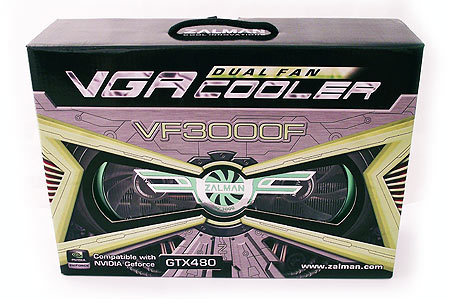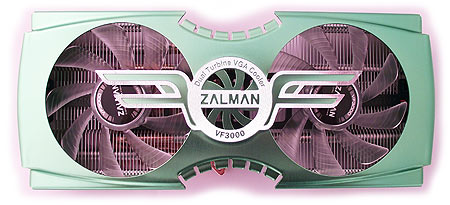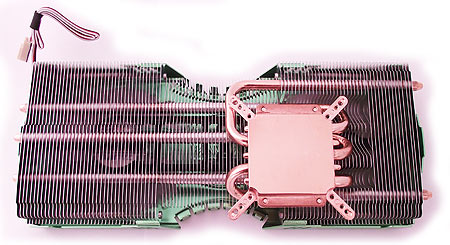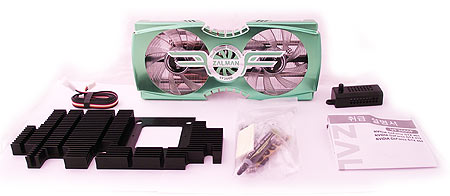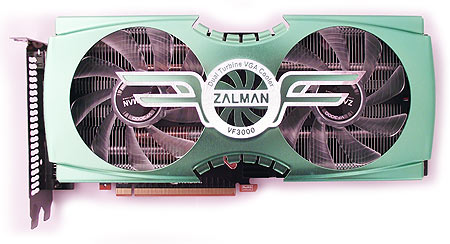Three Aftermarket Graphics Coolers On GeForce GTX 480
Today we're testing three of the largest graphics card coolers available: Arctic Cooling's Accelero XTREME Plus, DeepCool's V6000, and Zalman's VF3000F. Can these products bring performance to the table commensurate with their large triple-slot size?
Zalman VF3000F
Zalman’s VF3000 comes in a number of flavors: the VF3000A for the Radeon HD 5800-series, the Zalman VF3000N for the GeForce GTX 200-series, and the Zalman VF3000F, which is further split into two models (one for the GeForce GTX 465/470 and one for the GeForce GTX 480). All of these products share the same Zalman VF3000 cooler, but the VGA/RAM heatsink solutions for each one are unique.
Zalman does not use a number of small heatsinks for this task that would require thermal paste or tape, but employs a single heatsink plate that covers all of the RAM and VRMs at once. The advantage of this is that the metal sink can be screwed to the PCB and removed without adhesive concerns, while providing increased structural strength.
Separate models are priced differently. At the time of writing, the two VF3000F models cost about $68 on Newegg, while the VF3000A and VF3000N cost about $48 from the same e-tailer.
Zalman’s cooler is the lightest in our test group by far, weighing in at a relatively feather-like 430 grams (~15 oz.), compared to the other ~1lb 6oz. competitors. The VF3000 is about the same physical size as the rest of our test group at 51 mm wide, 98 mm tall, and 239 mm long. Unfortunately, a graphics card equipped with a VF3000 cooler will take up three PCIe slots, just like the rest of the options we’re looking at today.
Zalman’s aftermarket cooler features five copper heat pipes attached to a copper cooling block, with aluminum fins. Its dual 92 mm fan configuration is housed in a thin metal shroud. As far as I can tell, Zalman has not published the CFM airflow rating for the VF3000’s fans, although the company does boast how quiet it is. We’ll find out which cooler is the quietest in our noise benchmarks later.
This cooler comes with the RAM/VRM heatsink plate, instructions, mounting hardware, a surprisingly large syringe full of Zalman ZM-STG2 thermal grease, and an optional fan speed controller with cable. If you don’t want to use the controller to set the fan speed, you can plug the VF3000 directly into one of your motherboard’s fan headers.
Once again, the GeForce GTX 480 reference cooler has to be removed, and the contact surfaces have to be cleaned. With the prep done, there are no adhesives to worry about with this Zalman product. We simply apply the thermal grease to all of the necessary RAM and VRM contact surfaces and spread it evenly and thinly with a credit card. After that, we attach the RAM/VRM heatsink plate and screw it on the PCB with the provided hardware.
Get Tom's Hardware's best news and in-depth reviews, straight to your inbox.
Next we apply thermal grease to the GPU and attach the cooler, using the screw holes appropriate for our graphics card. The last step is to plug the fan cable directly into the motherboard. Alternatively. we could plug the fan into the fan controller cable, which would then be plugged in to the motherboard.
With installation of all three options covered, let’s get on with the testing.
Don Woligroski was a former senior hardware editor for Tom's Hardware. He has covered a wide range of PC hardware topics, including CPUs, GPUs, system building, and emerging technologies.
-
AMW1011 Wow, I can't believe the Accelero and the Zalman were basically neck and neck, with no tangible victory in cooling. I always thought the Accelero would be better, but Zalman actually pulled this one off.Reply
However, what would be AMAZING, is to have a follow-up to see which of these two solutions work best in SLI, assuming EITHER work well in SLI. I think that is the big question, especially since we never expected bad temps.
Also can you please add the voltages used for each overclock? It might give people, especially stock GTX 480 owners, a better idea of what these can handle, since cards will always vary when overclocking.
Holy ***, stock voltages! That is crazy! Please post up your VID (stock voltage) for us. Either you have a golden GTX 480, or the VID is a lot higher than it needs to be, which is pretty common.
Great article, I love to see these kind of side articles/reviews, and it was well done. -
Nerdbox87 Given that this entire article is based on cooling you really should have included all GPU temps - as vram / vrm cooling may be the difference between the Accelero and the Zalman (as I know my Accelero Twin Turbo on a 5850 struggled with vram temps in Furmark)Reply
On this my guess would be the Zalman would smash it -
joytech22 How was the 480 at just under 60C when my 470's are always idling at 86C in a Antec twelve hundred..?Reply
I mean sure this case isn't the best cooling case but there's never really much hot air in the case and with a sidepanel fan blowing on the two cards i just cant see how.
Unless.. you guy's test in a cool room at about 15-20C or the fan speeds are maxed 100% of the time. -
dvijaydev46 Oh, Zalman's cooler looks weaker than Accelero but the later actually outperforms a bit. That's amazing.Reply -
Th-z Don, what is your view on how to apply thermal paste. There are numbers of ways people talk about: a pea in the middle, several peas, line in the middle, several lines, and old school spread method. You use spread method when you apply the RAM/VRM sink on Zalman, I presume you use the same method on other parts, too. Maybe Tom can do a comparison test on different ways of applying thermal paste.Reply -
compton These look good and would help me out quite a bit with a 465/470, but I wish I could get them in a design that would help maintain the existing footprint. My GF100 doesn't run quite as hot as some reference card designs, but that sure as hell doesn't mean that I'm happy with the leaf blower lurking in my case. Maybe I find a way to make the Zalman work.Reply -
avatar_raq I think the Zalman one wins here. It performs slightly better, costs slightly less, weighs less and is shorter than the Arctic cooler. As for noise they're trading blows. Being shorter, the VF3000 does not increase the length of the GTX 480, unlike the accelero which may theoretically cause incompatibility with some cases. Being lighter, it strains the PCB much less. The fact it performed so close to the Arctic cooler with only 2 fans surprised me.Reply
